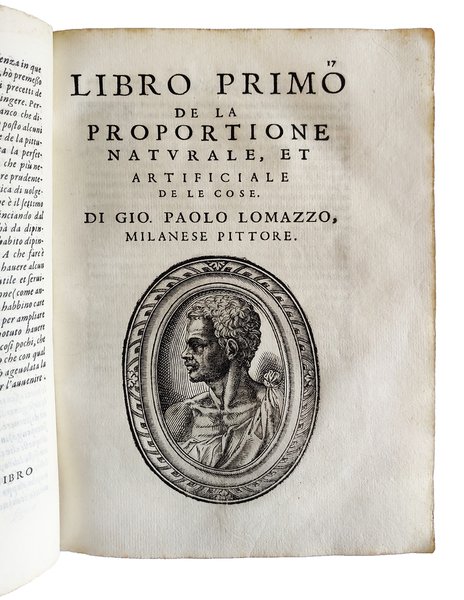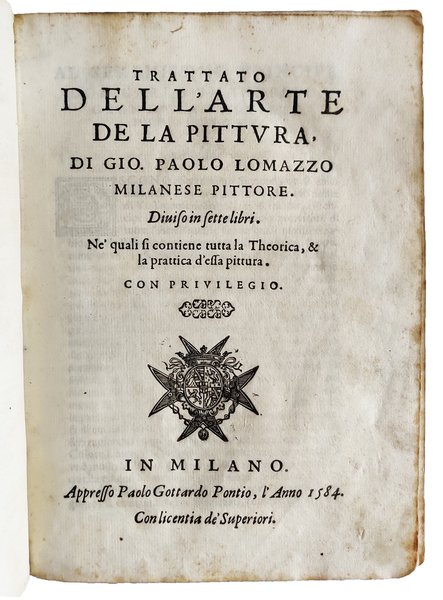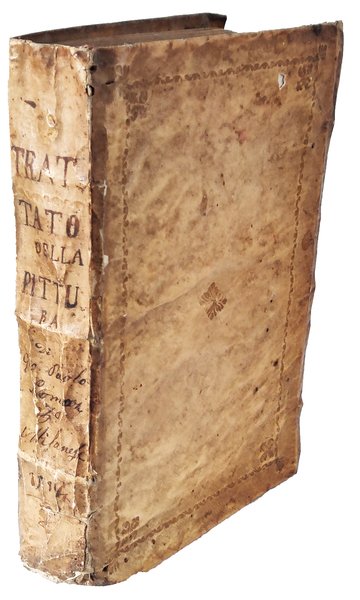



Libro
Lomazzo, Giovanni Paolo (1538-1592)
Trattato dell'arte de la pittura, di Gio. Paolo Lomazzo milanese pittore. Diviso in sette libri. Ne' quali si contiene tutta la theorica, and la prattica d'essa pittura
Paolo Gottardo da Ponte, 1584
non disponibile
Govi Libreria Antiquaria (Modena, Italia)
Parla con il LibraioLe corrette spese di spedizione vengono calcolate una volta inserito l’indirizzo di spedizione durante la creazione dell’ordine. A discrezione del Venditore sono disponibili una o più modalità di consegna: Standard, Express, Economy, Ritiro in negozio.
Condizioni di spedizione della Libreria:
Per prodotti con prezzo superiore a 300€ è possibile richiedere un piano rateale a Maremagnum. È possibile effettuare il pagamento con Carta del Docente, 18App, Pubblica Amministrazione.
I tempi di evasione sono stimati in base ai tempi di spedizione della libreria e di consegna da parte del vettore. In caso di fermo doganale, si potrebbero verificare dei ritardi nella consegna. Gli eventuali oneri doganali sono a carico del destinatario.
Clicca per maggiori informazioniMetodi di Pagamento
- PayPal
- Carta di Credito
- Bonifico Bancario
-
-
Scopri come utilizzare
il tuo bonus Carta del Docente -
Scopri come utilizzare
il tuo bonus 18App
Dettagli
Descrizione
4to (216x155 mm). [40], 700 [i.e. 698], [6] pp. Pages 693-694 omitted in pagination. Collation: †8 ††12 A-Vv8 Xx6 [χ]2. On title page woodcut coat-of-arms of the Savoy family, as the edition is dedicated by the author to Charles Emmanuel I, Duke of Savoy, from Milan on June 23, 1584. Woodcut oval portrait of the author on l. B1r. Woodcut decorative initials and ornaments. Roman and italic type. Errata, register and colophon on l. Xx6. Contemporary gilt vellum with overlapping edges, spine in four compartments each decorated with a gilt fleuron, inked title on spine, panels within a gilt frame with gilt corner pieces and a central fleuron, gilt and gauffered edges (lacking ties, stained and a bit darkened, small repair to the bottom of the spine, two small holes on the panels). Some marginal foxing, large staining to the last 15 leaves, small loss of paper to the lower outer corner of l. Dd3 with no loss, all in all a very good, genuine copy in an nice contemporary binding.
FIRST EDITION, first issue (a second issue appeared in 1585 with a reset title page), in the rare variant B with the addition of a final bifolium ([χ]2) containing an additional chapter to be placed after chapter 16 at p. 328 (Questo capitolo và collocato nel sesto libro doppo il capitolo 16. à car. 328).
Lomazzo's Trattato is considered as a milestone in early Mannerist art theory and a main source for the reception and circulation of Leonardo's works. Lomazzo, who was a member of the artistic Accademia della Val di Blenio, firmly belonged to the Milan Counter-Reformation environment dominated culturally by the figure of St. Carlo Borromeo and artistically by the legacy of Leonardo da Vinci.
"His Trattato dell'Arte della Pittura (1584) along with the later Idea del Tempio della Pittura (1590), constitutes one of the most complete attempts to give a defined structure to the art of painting [.] A complex book such as the Trattato had the ambitious aim of summing up the ideas and notions of the different parts of painting (proportion, movement, color, light and perspective) and of positioning the art of painting in its rightful place among the liberal arts. It could not have seen the light unless the cultural climate in Milan during the sixteenth century had been favorable. The Trattato, which was published in Milan in 1584 by Paolo Gottardo Pontio (or da Ponte), is divided into seven books. The first five books deal with the different elements of painting ["On the Natural and Artificial Proportion of Things', "On Movement', "On Color', "On Light', and "On Perspective'], while the last two books are called "The Practice of Painting' and "On the History of Painting'. The division of the book will serve as example for other Italian writings on art of the period, such as Armenini's De' Veri Precetti della Pittura, which was published only three years after the "Treatise' and whose second book is mainly divided into light, shadows, foreshortenings, color, and storie. On the other hand, it differs from the traditional "dialogue" form adopted by previous writers on art, such as Paolo Pino's Dialogo della Pittura (1548) or Dolce's Aretino (1557). The dialogue form was used by Lomazzo only for the Libro de' Sogni. The planning of the book was affected by Lomazzo's progressive eye-illness. He rearranged the chapters several times, adding new sections almost certainly with the help of different people, but, as Ackerman pointed out, he was likely unable to rewrite the older ones. There is still discussion on the issue of who helped him to structure the books (both the "Treatise' and the Idea). I tend to believe that, among others, he was assisted by the literate Giuliano Goselini and Bernardino Baldini, the authors of the two sonnets at the beginning of the book, whom Lomazzo knew thanks to his participation in the Blenio academy. Although they were probably not "editors' or practical helpers in the dictation of the book, they were likely consulted by Lomazzo in the process of choosing the classical authors to refer to in the text (B. Tramelli, Giovanni Paolo Lomazzo's "Trattato dell'Arte della Pittura': Color, Perspective and Anatomy, Leiden-Boston, 2017, pp. 77-79).
Lomazzo was born in Milan in 1538. The scant information we have about his life and activity comes from Lomazzo himself, as he left an autobiography in verse printed as an appendix to the edition of his Rime (1587). There (p. 401) he tells us that he studied music under maestro Giovan Michele Gerbo and at the age of fourteen entered the school of the Novara painter, also active in Milan, Giovanni Battista Della Cerva, a pupil and collaborator of Gaudenzio Ferrari. In 1561 Lomazzo began to work on his own as a painter, receiving an official license the following year issued in the name of Philip II. Between 1561 and 1564 he made a trip to Rome in order to "veder le pitture et anticaglie" ("to see the paintings and the antiquities', Rime, p. 532). The trip probably included a stop in Bologna (a hint is in Rime, p. 303) and another in Florence, "illustrious and rich" in works of art (Trattato, p. 587), and then after Rome continued on to Naples and Messina. In Florence, Lomazzo was particularly interested in Mannerist painting: the lively and sincere appreciation in the Trattato and in his other writings for artists such as Rosso Fiorentino, Polidoro da Caravaggio, Perin del Vaga, Giorgio Vasari (whose Vite, in the 1550 Torrentino first edition, Lomazzo was also thoroughly familiar with), Salviati and even the lesser-known Girolamo Macchietti, seems to be based on the memory of firsthand vision. Some hints in the Rime seem also to suggest a possible stay in Turin, which should have taken place between 1556 and 1559 (Rime, pp. 158 and 302); it is also significant to note here that Lomazzo will dedicate the Trattato to Charles Emmanuel of Savoy, who became duke in 1580. Outside Italy, Lomazzo almost certainly visited Flanders, deeply attracted as he was by Flemish painting: his independence of judgment, the telling of unpublished anecdotes, and the hints at characteristic and otherwise unknown nicknames, confronted not only with the second edition of Vasari's Vite (1568), but also with primary sources on Flanders such as Lodovico Guicciardini's Descrittione di tutti i Paesi Bassi (1567) and Domenicus Lampsonius's Pictorum aliquot celebrium Germaniae inferioris effigies (1572), make fully credible the reference, contained in the Rime (p. 107), to a sojourn in Antwerp. In Antwerp, Lomazzo came also probably into contact with W. Huysmann, who dedicated a Latin poem to him, later published in the first edition of the Trattato.
His autobiography in verse is also the main source for reconstructing the catalog of Lomazzo's pictorial work, mostly made of portraits. Lomazzo's pictorial activity is particularly impressive in its vastness when one considers that it was encompassed in the space of little more than fifteen years, due to the blindness that struck him in early 1572. Most of his completed paintings, however, have been destroyed or dispersed. Due to the blindness that occurred when he was only thirty-three years old, Lomazzo had to give up painting and could only devote himself to writing. His possession of a large number of texts by other artists, including most notably Leonardo da Vinci, shows however that he had a strong interest in the theory of painting long before his eyes problem forced him to give up his activity as a painter. Between 1584 and the year of his death (1592), Lomazzo published the Trattato dell'arte de la pittura (1584), the Rime (1587), the Rabisch (1589), the Idea del tempio della pittura (1590), and the Della forma delle muse (1591). The Libro de sogni, the only writing by Lomazzo whose autograph manuscript is preserved (London, British Library, Add. Mss., 12196), remained unpublished until a few years ago (Scritti sulle arti, R.P. Ciardi, ed., Florence, 1973-75) (cf. R. Ciardi, Lomazzo, Giovanni Paolo, in: "Dizionario Biografico degli Italiani", vol. 65, 2005, s.v.).
Edit 16, CNCE24452; Adams, L-1419; Cicognara, 4612; Fowler, 186; Vagnetti, EIIb34; Comolli, I, pp. 18-24, Berlin Katalog, 4612; Schlosser-Magnino, pp. 395-396.
